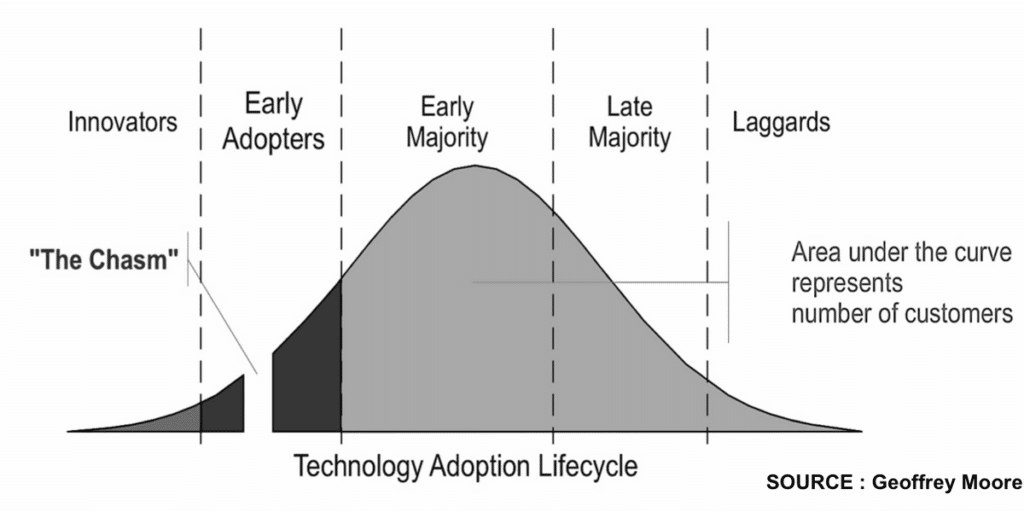We all know that tech is moving at lightning speed ⚡. One minute you’re learning something new, and the next, something even bigger and better comes out. It can be overwhelming, right? I’ve been there too, wondering if I should jump on the latest trends or wait it out. Let me share my thoughts on this and help you figure out when is the right time to adopt new technology, using the technology adoption lifecycle as a guide.

The Technology Adoption Lifecycle: Don’t Rush It!
First off, there’s something called the technology adoption lifecycle. Sounds fancy, but it’s just a way to describe how different groups of people jump on new tech. Here’s the breakdown:
- Innovators: These people are the first ones to try out new tech. They’re willing to take the risks, even when things are super buggy. They love being ahead of the curve 🚀.
- Early Adopters: They follow the innovators. They’re still early, but they wait a little longer to make sure things work. They’re the trendsetters in their circles.
- Early Majority: These people are more cautious. They wait for the tech to be proven and then join in. By the time they adopt it, it’s pretty reliable, but they’re not the first ones.
- Late Majority: These folks are skeptics. They wait until everyone else has jumped on the bandwagon before they even consider it. It’s the last group to get on board.
- Laggards: These are the folks who stick with what they know, even when the new tech is everywhere. They’re the last to adopt and sometimes only do so when they have no choice.
This whole technology adoption lifecycle is about understanding where you fit in the cycle and how you can strategically decide when to adopt new tech.
So, Why Wait?
I get it—sometimes it feels like if you don’t adopt new tech right away, you’ll be left behind. But here’s the thing: it’s okay to wait. Being an early adopter isn’t always the best choice. Why?
- Risk of Bugs and Instability: Early versions of tech are often glitchy. The last thing you want is to waste time dealing with bugs and crashes 🐞.
- Cost: New tech can be expensive, especially when it’s fresh on the market 💸. Waiting gives you time to see if the price drops or if there are better options.
- Uncertain Longevity: Not every new tech becomes a game-changer. A lot of stuff gets hyped up and then fades away. Waiting helps you avoid investing in something that doesn’t last.
When is the Right Time to Adopt?
Okay, so when should you jump in? It’s not about being the first—it’s about knowing the right moment in the technology adoption lifecycle:
- When it’s Proving Itself: Look at how others are using it. If the tech is getting good reviews and solving real problems, it might be time to consider it.
- When It’s Mainstream But Not Overcrowded: Sometimes waiting until a tech becomes mainstream is your best bet. It’s stable, people know how to use it, and it’s proven its worth. But, if you wait too long, you might lose the competitive edge.
- When It’s Becoming a Standard: If the tech is getting adopted by key players in your field, it’s probably time to start thinking about using it. You don’t want to be left behind, but you also don’t want to be jumping into something that’s still too new.
How to Stay in the Loop Without Stressing
You don’t need to become an expert on every new tech, but you should stay in the loop. Here’s how:
- Follow the Right People: Stay updated by following influencers and experts in your industry. Twitter, LinkedIn, and blogs are great for this.
- Join Communities: Online forums and groups can help you stay ahead of trends and get feedback from others who are already using new tech 🌐.
- Test It Out First: Start small. Try the tech on a smaller scale before going all in. You can learn and figure out if it fits your needs.
It’s All About Balance
So, should you adopt new tech? Yes, but don’t rush it. It’s about balance—waiting for the tech to prove itself while staying informed so you don’t get left behind. There’s no harm in waiting for things to stabilize before jumping in, and trust me, it’ll save you a lot of stress in the long run.
Tech isn’t going anywhere, and there’s always time to learn. So, don’t let the fear of being left out drive you to make rushed decisions. Stay smart, stay informed, and you’ll always be ready for the next big thing—on your own terms.

